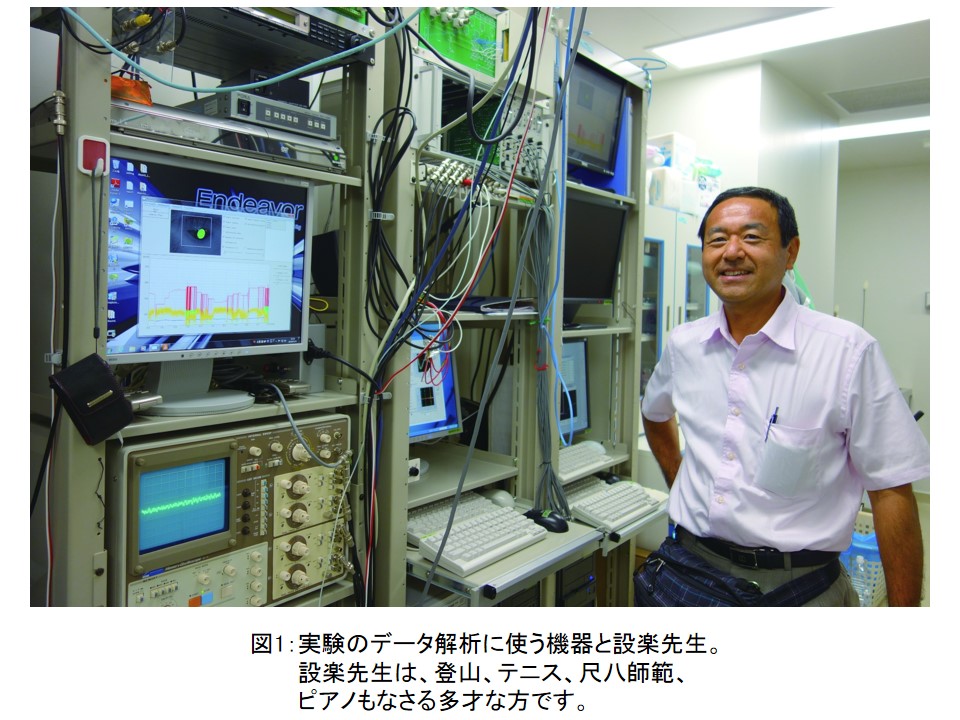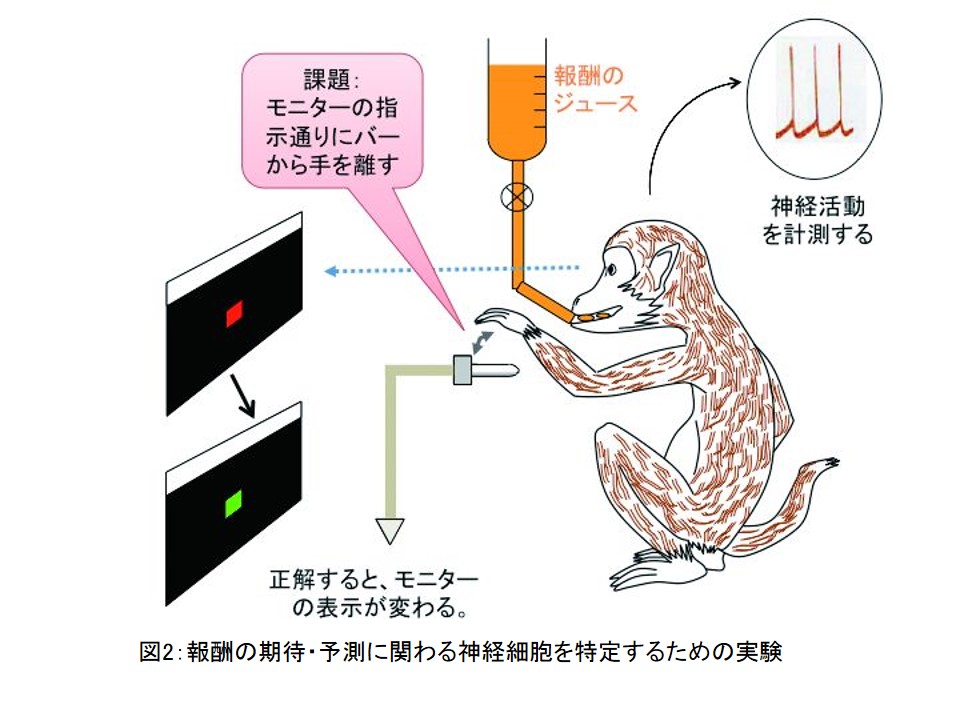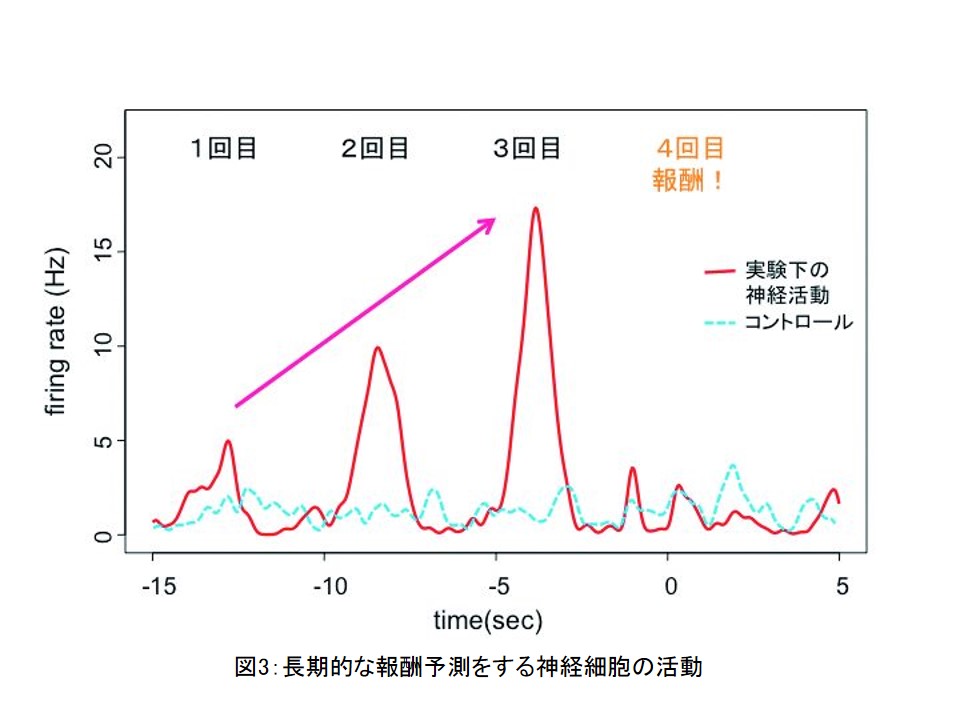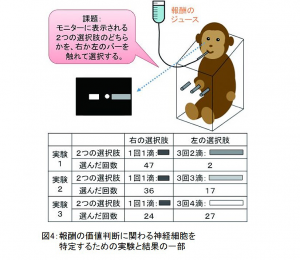キーワード:報酬価値、行動決定、脳内情報処理、霊長類動物モデル、理論神経科学
http://www.md.tsukuba.ac.jp/basic-med/physiology/sys-neurosci/
 脳は、与えられた状況を判断し、最善の行動をとれるように情報を処理する機能を持っています。生存に必須の食料や幸福感など感性を充たすもの、つまり「生体にとってプラスの価値を持つもの」を報酬としたとき、脳はどのように報酬の期待や予測、その価値判断を行っているのでしょうか。本研究は、神経生理学を中心に据えつつ、行動学、心理学、分子生物学、薬医学の知識を融合し、さらに、計算生物学や数理、進化ゲーム論などの経済学の研究を絡めることで、脳の情報処理の事象を総合的に理解するだけでなく、根本的なメカニズムの解明にも挑みます(図1)。
脳は、与えられた状況を判断し、最善の行動をとれるように情報を処理する機能を持っています。生存に必須の食料や幸福感など感性を充たすもの、つまり「生体にとってプラスの価値を持つもの」を報酬としたとき、脳はどのように報酬の期待や予測、その価値判断を行っているのでしょうか。本研究は、神経生理学を中心に据えつつ、行動学、心理学、分子生物学、薬医学の知識を融合し、さらに、計算生物学や数理、進化ゲーム論などの経済学の研究を絡めることで、脳の情報処理の事象を総合的に理解するだけでなく、根本的なメカニズムの解明にも挑みます(図1)。

報酬が期待・予測されるときには、ある特定の神経細胞が活発に活動する
まず注目しているのは、報酬の期待や予測です。例えばサルに課題を与え、それができればジュース1滴の報酬を与えるとします。課題には4段階あり、4回正解しないと報酬はもらえません(図2)。すると、3回目、4回目とすすむにつれて誤答率が少なくなり、回答する反応時間も早くなるのです。このとき活発になっている大脳基底核の神経細胞が、即時的な報酬への期待に反応する細胞と特定でき、その活動が行動の変化にも現れていることが分かりました。さらに、1 回、2回、3回とすすむにつれてだんだん反応が大きくなる前頭葉内側部の神経細胞も特定し(図3)、これは長期的な報酬予測をする神経細胞と判明しました。


神経細胞の機能の解析から、脳の情報処理の原理解明、そしてその応用までを考える
報酬の価値判断の研究では、例えば1回の課題を正解してジュース1滴の報酬がもらえる場合と、3回3滴の場合の、どちらかをサルに選択させます。どちらも算術的には1回につき1滴ですから等価なのですが、実際には70%の確率で1回で1滴もらう方を選びました。これは、時間が経つ程報酬の価値が下がるからです(報酬価値の割引)。しかし、1回1滴の場合と、3回4滴の場合の選択にすると、3回4滴を選ぶことが増えます(図4)。つまり、報酬を増やすことで時間による割引分が補われるのです。この価値判断を行う神経細胞を特定すると同時に、報酬価値の割引率が、どのように制御されるのかも研究しています。
このような研究から脳の情報処理の原理を突き止め、脳疾患の治療法や生活支援ロボットの開発への応用も目指しています。

社会への貢献・実績
● 現在脳科学で最もホットなトピックの1つである、行動決定と価値判断の脳内情報処理の仕組みの解明に寄与
● 神経科学、計算理論、行動心理学、ゲーム理論を融合し、学際融合研究のモデルとして展開
● 広義の報酬の価値判断の脳内情報処理機構解明は、購買行動などのマーケティングの分野にも貢献
● 神経科学や報酬価値判断メカニズムに基づく効果的な教育法の開発、脳内報酬系の障害が背景機序となっている薬物乱用や虐待、注意欠陥障害や躁病、鬱病、人格障害などの精神疾患事例の治療・再教育法発展にも寄与することを目指す
(取材:平成25年7月22日)
Clarifying the Fundamental Mechanisms of the Brain Information Processing for Decision-making
The brain processes information to appropriately recognize a given situation and perform optimal behavior. Considering items with a positive value for living organisms as rewards, such as food  indispensable for life or happiness, how is the brain conducting processing of reward expectation and value judgments? This research unit comprehensively examines the information-processing of the brain by combining neurophysiology with behavioral science, psychology, molecular biology, medicine, and pharmacology, as well as economics covering computational biology, mathematics, and the evolutionary game theory. It also aims to clarify the fundamental mechanisms of the brain (Figure 1).
indispensable for life or happiness, how is the brain conducting processing of reward expectation and value judgments? This research unit comprehensively examines the information-processing of the brain by combining neurophysiology with behavioral science, psychology, molecular biology, medicine, and pharmacology, as well as economics covering computational biology, mathematics, and the evolutionary game theory. It also aims to clarify the fundamental mechanisms of the brain (Figure 1).

Figure 1: Professor Shidara Standing by Devices for Experimental Data Analysis; he is a multi-talented person who enjoys mountain-climbing, tennis, shakuhachi (bamboo flute) master, and piano.
Neurons with Reward Expectation
In another experiment on reward value judgments, a monkey was allowed to select one of two options: 1 drop of juice for 1 appropriate answer; or 3 drops of juice for 3 appropriate responses. Although they are arithmetically equal, 1 drop of juice in reward for 1 appropriate answer, the monkey chose the former option at a rate of 70%, considering a decrease in the reward value with time and workload (discounting of delayed rewards). In contrast, when the options were: 1 drop of juice for 1 appropriate answer; or 4 drops of juice for 3 appropriate responses, the monkey chose the latter at a little higher rate (Figure 4). By changing options of reward size and time/workload, we can clarify the mechanism of value judgments, and we are now analyzing value-coding neurons in orbitofrontal cortex.
Through these studies, we aim to clarify the information-processing mechanism of the brain, and use the results for the development of treatment methods for brain diseases and life-supporting robots.
Social contributions and achievements
● Contributing to clarification of the information-processing mechanism of the brain for decision-making and value judgments as one of the most important issues in neuroscience today
● Combining neuroscience, computational theories, behavioral psychology, and game theories as an interdisciplinary research model
● Contributing to the field of marketing by applying findings on the information-processing mechanism of the brain for reward value judgments to purchase patterns
● Developing effective education methods based on neuroscience and the mechanism of reward value judgments. We also hope to contribute to the development of treatment and re-education methods for mental disorders due to impairment of the brain reward system, such as drug abuse, attention deficit disorder, mania, depression, and personality disorder.

